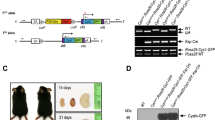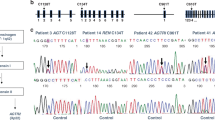Abstract
Major genes which cause tuberous sclerosis (TSC) and autosomal dominant polycystic kidney disease (ADPKD), known as TSC2 and PKD1 respectively, lie immediately adjacent to each other on chomosome 16p. Renal cysts are often found in TSC, but a specific renal phenotype, distinguished by the severity and infantile presentation of the cystic changes, is seen in a small proportion of cases. We have identified large deletions disrupting TSC2 and PKD1 in each of six such cases studied. Analysis of the deletions indicates that they inactivate PKD1, in contrast to the mutations reported in ADPKD patients, where in each case abnormal transcripts have been detected.
This is a preview of subscription content, access via your institution
Access options
Subscribe to this journal
Receive 12 print issues and online access
$209.00 per year
only $17.42 per issue
Buy this article
- Purchase on Springer Link
- Instant access to full article PDF
Prices may be subject to local taxes which are calculated during checkout
Similar content being viewed by others
References
Gomez, M.R., Tuberous Sclerosis, 2nd edition (Raven Press, New York, 1988).
Shepherd, C.W., Gomez, M.R. & Lie, J.T. Causes of death in patients with tuberous sclerosis. Mayo Clin. Proc. 66, 792–796 (1991).
Green, A.J., Smith, M. & Yates, J.R.W. Loss of heterozygosity on chromosome 16p in hamartomas from tuberous sclerosis patients. Nature Genet. 6, 193–196 (1994).
Green, A.J. & Yates, J.R.W. The tuberous sclerosis gene on chromosome 9q34 acts as a growth suppressor. Hum. molec. Genet. 3, 1833–1837 (1994).
Stillwell, T.J., Gomez, M.R. & Kelalis, P.P. Renal lesions in tuberous sclerosis. J. Urol. 138, 477–481 (1987).
van Baal, J.G., Fleury, P. & Brummelkamp, H. Tuberous sclerosis and the relation with renal angiomyolipoma. A genetic study on the clinical aspects. Clin. Genet. 35, 167–173 (1989).
Zimmerhackl, L.B., Rehm, M., Kaufmehl, K. & Brandis, M. Renal involvement in tuberous sclerosis complex: a retrospective survey. Pediat Nephrol. (in the press).
Cree, J.E. Tuberous sclerosis with polycystic kidneys. Proc. R. Soc. Med. 62, 327 (1969).
Wenzl, J.E., Largos, J.C. & Albers, D.D. Tuberous sclerosis presenting as polycystic kidneys in an infant. J. Pediatr. 77, 673–676 (1970).
O'Callaghan, T.J., Edwards, J.A., Tobin, M. & Mookerjee, B.K. Tuberous sclerosis with striking renal involvement in a family. Arch. intern. Med. 135, 1082–1087 (1975).
Stapleton, F.B., Johnson, D., Kaplan, G.W. & Griswold, W. The cystic renal lesion in tuberous sclerosis. J. Pediatr. 97, 574–579 (1980).
Webb, D.W., Super, M., Normand, C.S. & Osborne, J.P. Tuberous sclerosis and polycystic kidney disease. Brit. med. J. 306, 1258–1259 (1993).
The European Chromosome 16 Tuberous Sclerosis Consortium. Identification and characterisation of the tuberous sclerosis gene on chromosome 16. Cell 75, 1305–1315 (1993).
The European Polycystic kidney disease 1 gene encodes a 14kb transcript and lies within a duplicated region on chromosome 16. Cell 77, 881–894 (1994).
Nellist, M., Brook-Carter, P.T., Connor, J.M., Kwiatkowski, D.J., Johnson, P. & Sampson, J. Identification of markers flanking the tuberous sclerosis locus on chromosome 9 (TSC1). J. med. Genet. 30, 224–227 (1993).
Cole, B.R., Conley, S.B. & Stapleton, F.B. Polycystic kidney disease in the first year of life. J. Pediatr. 111, 693–699 (1987).
Schmickel, R.D. Contiguous gene syndromes: a component of recognizable syndromes. J. Pediatr. 109, 231–241 (1986).
Fink, G.M. et at. Characteristics of very early onset autosomal dominant polycystic kidney disease. J. Am. Soc. Nephrol. 3, 1863–1870 (1993).
Bernstein, J. & Robbins, T.O. Renal involvement in tuberous sclerosis. Ann. N. Y. Acad. Sci. 615, 36–49 (1991).
Zerres, K., Rudnik-Schönebom, S. & Deget, F. Childhood onset autosomal dominant polycystic kidney disease in sibs: clinical picture and recurrence risk. J. med. Genet. 30, 583–588 (1993).
Fink, G.M., Johnson, A.M. & Gabow, P.A. Is there evidence for anticipation in autosomal dominant polycystic kidney disease? Kidney Int. 40, 1153–1162 (1994).
Mandel, J.-L. Questions of expansion. Nature Genet. 4, 8–9 (1993).
Hermann, B.G., Barlow, D.P. & Lehrach, H. A large inverted duplication allows homologous recombination between chromosomes heterozygous for the proximal t complex inversion. Cell 48, 813–825 (1987).
Sambrook, J., Fritsch, E.F. & Maniatis, T. Molecular cloning: a laboratory manual. 2nd edn (Cold Spring Harbor, Laboratory Press, New York, 1989).
Peral, B. et al. Evidence of linkage disequilibrium in the Spanish polycystic kidney disease 1 population. Am. J. hum Genet. 54, 899–908 (1994).
Pinkel, D. et al. Fluorescence in situ hybridization with human chromosome specific libraries: detection of trisomy 21 and translocations of chromosome 4. Proc. Natn. Acad. Sci. U.S.A 85, 9138–9142 (1988).
Lichter, P. et al. High resolution mapping of human chromosome 11 by in situ hybridization with cosmid clones. Science 247, 64–68 (1990).
Frohman, M.A., Dush, M.K. & Martin, G.R. Rapid production of full-length cDNAs from rare transcripts: amplification using a single gene-specific oligonudeotide primer. Biochemistry 85, 8998–9002 (1988).
Author information
Authors and Affiliations
Rights and permissions
About this article
Cite this article
Brook-Carter, P., Peral, B., Ward, C. et al. Deletion of the TSC2 and PKD1 genes associated with severe infantile polycystic kidney disease — a contiguous gene syndrome. Nat Genet 8, 328–332 (1994). https://doi.org/10.1038/ng1294-328
Received:
Accepted:
Issue Date:
DOI: https://doi.org/10.1038/ng1294-328
This article is cited by
-
Nutrient-sensing mTORC1 and AMPK pathways in chronic kidney diseases
Nature Reviews Nephrology (2023)
-
Cystic kidney disease in tuberous sclerosis complex: current knowledge and unresolved questions
Pediatric Nephrology (2023)
-
Blood pressure and glomerular filtration rate in youth with tuberous sclerosis complex
European Journal of Pediatrics (2022)
-
Unexpected diagnosis in a child with hemolytic uremic syndrome: Answers
Pediatric Nephrology (2021)
-
Renal tumors in tuberous sclerosis complex
Pediatric Nephrology (2021)



